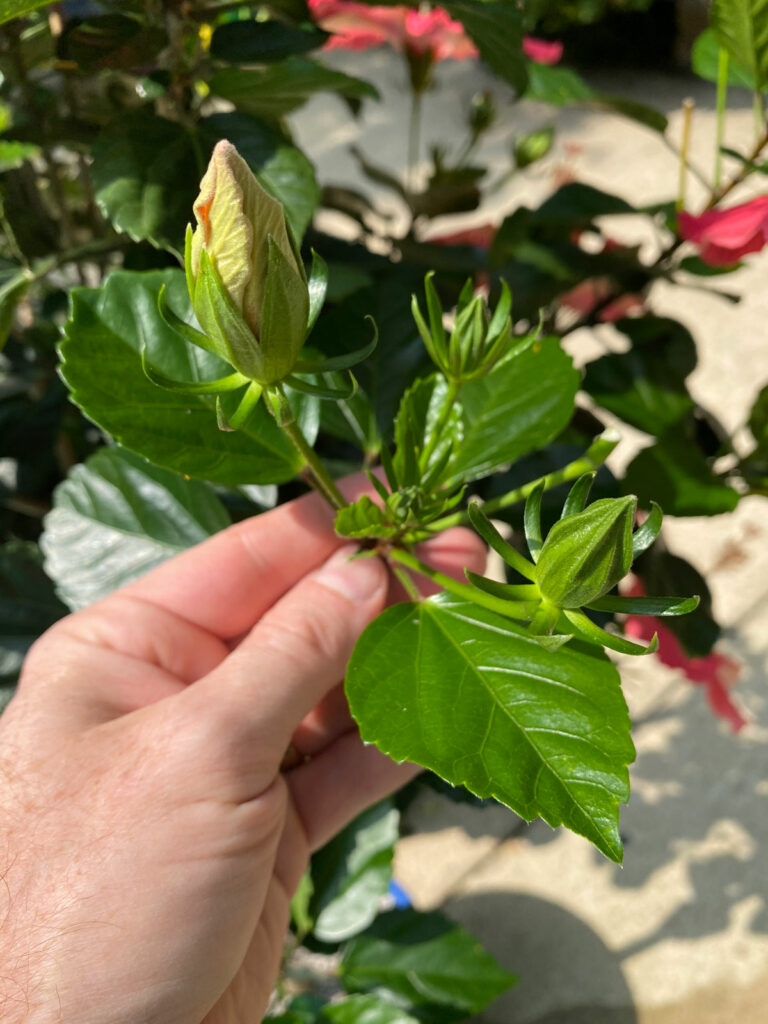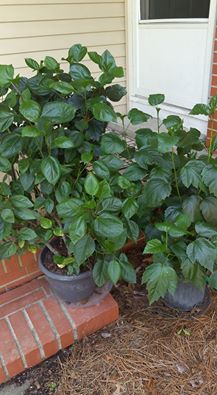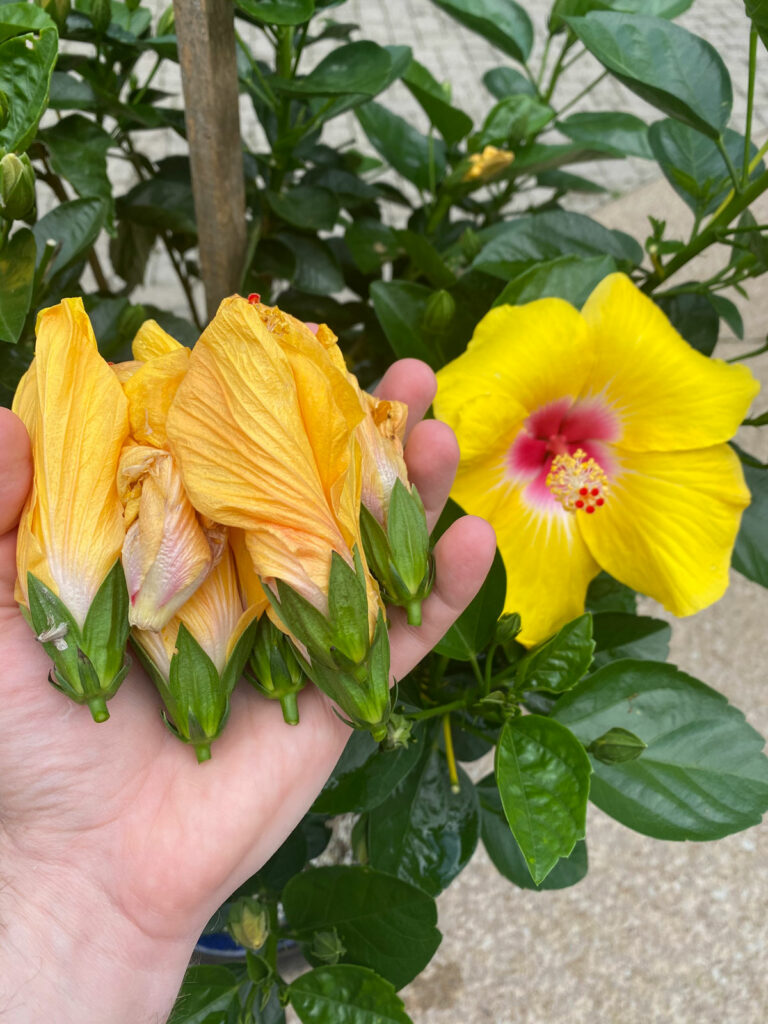
If hibiscus receives excessive shade, is drought-stressed, or is extensively clipped in late spring, it will not bloom. With fewer flowers produced by hibiscus due to excessive nitrogen fertilization, flowering is also inhibited by excessive phosphorus fertilization.
Summer is the blooming season for hibiscus. Continue reading to find out why and how to encourage flowers on your hibiscus if it hasn’t flowered yet.
Table of Contents
1. Too Much Shade Prevent Hibiscus Flowering
The quantity of sunlight a hibiscus receives each day is crucial for it to bloom.
Hibiscus grows to its fullest potential and produces an abundance of fragrant flowers in direct sunlight.
The less energy the plant has to put on exhibit as flowers in the summer, the more shadier the area of your garden where your hibiscus is located.
Hibiscus are native to Asia’s bright, humid, tropical, and subtropical climes, where they bloom in hot weather and direct sunlight.
Both the tropical species of hibiscus (Hibiscus rosa-sinensis) and the hardier species of hibiscus (Hibiscus spp.) require full sun for flowering, therefore always plant your hibiscus in a location with six or more hours of sunlight (hardier hibiscus can tolerate cooler temperatures).
If your hibiscus is indoors or in a shady section of your garden, it is residing in unfavorable conditions that stress the plant and prevent it from flowering.
If at all possible, remove any foliage that is shading your hibiscus or, if it is in a pot, transfer it to a patio that receives enough of sunlight.
Although hibiscus aren’t always the best houseplants, only the tropical types may be grown inside. To encourage blooming, place your hibiscus in the sunniest window in your home.
2. Too Much Phosphorous can Prevent Hibiscus Blooming
Although phosphorus is frequently the main component of fertilizer “bloom boosters,” hibiscus blossoming is negatively impacted by their use because hibiscus is particularly sensitive to an accumulation of phosphorous in the soil.
The hibiscus plant can cease flowering or even die if there is too much phosphorus in the soil because it stops the roots from absorbing other vital minerals.
Avoid using excessive amounts of fertilizer and steer clear of unbalanced fertilizers (a well-balanced fertilizer has an even ratio of nitrogen, phosphorus, and potassium, or NPK). Instead, focus on enhancing soil fertility with organic mulches (such as well rotted manure).
Since hibiscus is peculiar in that it is sensitive to phosphorus, gardeners frequently attribute the absence of the blossoms to this issue.
(One of the reasons why hibiscus leaves become yellow is too much phosphorous, but there are other causes, so I made another post for the remedy.)
3. Too Much Nitrogen Prevents Hibiscus Flowering
When using fertilizer in excess, hibiscus are vulnerable to too much phosphorus and even nitrogen.
It’s vital to moderate your nitrogen applications because too much nitrogen can lead your hibiscus to produce more foliage than blossoms.
The hibiscus’ susceptibility to pests like aphids, which feed on sap and can cause flower buds to fall off if infested, can also be increased by overfertilizing.
Hibiscus are strong feeders, however as previously mentioned, the best approach to feed them is to add mulch to the soil (compost, leaf mold, or well-rotted manure) and possibly use a half-strength general liquid fertilizer from a brand like miracle-gro, once a month during the Spring and Summer.
This is frequently an excellent balance to provide the hibiscus the nutrients it needs to produce blossoms without giving the plant too much and preventing it from flowering.
Reduce your hibiscus’ fertilizer use and give it regular watering if it has a lot of foliage but no flowers.
It might not have flowers this year, but if fertilizer is done more consistently, the hibiscus should bloom the next year.
4. Pruning at the Wrong Time of Year

Heavy spring pruning might either prevent the hibiscus from blooming in the summer or substantially delay it.
If flowering is put off, the flowers are more likely to bloom when the weather is cooler in the fall than it is in the summer, and they frequently wilt or fade much more quickly than they would.
After blossoming in approximately September or October, hibiscus responds well to a modest pruning at the end of the growing season so that new growth in the spring can support the flowers.
5. Hibiscus in Pots Not Blooming
The same causes of hibiscus not flowering also apply to hibiscus in pots, however there are a few circumstances unique to pots that can prevent your hibiscus from blooming.
If the hibiscus in your container isn’t flowering, it’s usually because:
- The hibiscus has used up all of the nutrients in the pot because it has been there for a long time. Because of the reduced soil volume in pots, fewer nutrients are accessible. Additionally, the soil in pots has a tendency to compress over time, and frequent watering removes nutrients that are water soluble.
- Small pots dry out far too fast. To flower, hibiscus needs full sunlight, warm temperatures, and continually moist soil. Even with regular watering, your hibiscus suffers from drought stress in smaller pots because they hold less water and heat up the soil more quickly. This inhibits hibiscus from blossoming.
- pots without base drainage holes. Hibiscus need soil that drains properly, therefore if they are planted in decorative pots without a drainage hole in the base, water pools around the roots and produces root rot, which inhibits the plant from blossoming and can cause it to die back.
- In smaller pots, the roots may become entrapped in the container and even obstruct the drainage openings, which results in slower drainage, soggy soil, and a higher risk of disease.
To encourage plant health and flowering, you should repot your hibiscus if it has been growing in the same soil for a long time.
Use high-quality multipurpose compost for repotting for improved soil structure and moisture-retention ability.
The hibiscus should be replanted in a larger container so that the roots may grow and have access to the nutrients and moisture they need to flower without drying out too rapidly in the hot Summer sun.
A one-inch layer of gravel should be placed in the bottom of the pot to provide proper drainage, and the pot or container should have drainage holes in the base.
(Read my post on how to revive dying hibiscus to understand how to save hibiscus.)
6. Climate can Affect Hibiscus Flowering
Hibiscus are indigenous to Asia’s tropical and subtropical regions, where they flourish in warm, sunny, humid weather.
Gardeners cultivate one of two hibiscus species:
- Hawaiian hibiscus (Hibiscus rosa-sinensis)
- H. spp., or hardy hibiscus
Hibiscus from the tropics normally prefers warmer, more humid environments and cannot endure freezing temps (hardy in USDA Zones 9-11).
The tropical hibiscus normally blooms for a shorter period of time than the hardy species, though this might vary depending on the particular variation.
Tropical plants are significantly more difficult to maintain outside of their native climes, and as a result, they do not flower as frequently because they are frequently under stress if the environment is unfavorable.
The hardy species typically blooms more easily in a wider variety of environments and climates.
If you’re having trouble getting your hibiscus to bloom, find out what species the variety belongs to and grow the right hibiscus for your climate. This will increase the floral display.
7. Hibiscus do Not Flower Due to Drought Stress
Hibiscus are indigenous to the tropics and thrive in moist, organic soil where it rains frequently.
Your hibiscus may not be blooming because it is under stress from the drought.
Typically, drought stress is brought on by:
- a lack of watering While mature and established hibiscus may not need as much watering on a regular basis, young and potted hibiscus plants should receive as much water as necessary to keep the soil continuously moist and encourage summer blooms.
- Sandy soil is unable to hold onto moisture well. Sand or stone-rich soil often drains too quickly for hibiscus roots to absorb moisture, leading to drought stress and possibly reduced flowering.
I suggest giving your hibiscus a good soak with a hose to increase the soil’s ability to absorb moisture, and then covering the soil around your hibiscus with a layer of mulch.
Compost, leaf mold, and well-rotted manure are ideal mulches for hibiscus because they hold moisture, add nutrients, and keep the pH of the soil at a level that is suitable for your hibiscus.
Applying a layer of mulch around your hibiscus plants at the start of spring will also help the soil structure.
Your environment and weather will influence how frequently you should water your plants, but you can predict how soon your soil will dry out by routinely testing it for moisture to a finger’s depth.
Give your hibiscus a deep bath as soon as the soil is dry to maintain a strong plant that produces blossoms in the summer.
8. Hibiscus Does Not Flower in Slow Draining Soils
Hibiscus won’t bloom if the ground is soggy, which is the opposite of what happens in most situations. Hibiscus needs regularly wet soil, but it also needs soil that drains well.
The hibiscus may experience stress that prevents it from flowering and fosters the circumstances for a fungus illness like root rot, which can cause your hibiscus to die back, if the soil is thick clay or compacted and water collects around the roots of the plant.
Reduce watering if the soil seems or feels extremely soggy to give the area around the roots a chance to dry out.
Hibiscus frequently doesn’t survive for very long in saturated soils like thick clay, so you should transplant it to a spot with well-draining soil or, if it’s tiny enough, into a pot.
For low-lying, swampy gardens, I advise planting hibiscus in pots, containers, or raised beds because they have better drainage and allow you to modify the soil profile so that it is suitable for hibiscus to grow and flower. This is much simpler than amending the soil in low-lying, marshy gardens.
9. Pests Can Cause Hibiscus Flower Buds To Fall Off

These stressors include:
- drought-related water stress or soggy soil.
- A surplus of fertilizer.
- nutrient-deficient soil
More soft and succulent foliage grows as a result of too much nitrogen from fertilizer, which in turn attracts pests including mealy bugs, aphids, thrips, and spider mites.
Check the leaves for signs of insect infestations, and if you find any, use an organic insecticide made from neem oil (available at garden centers and on Amazon). Neem oil is not poisonous to other animals in your garden, and it can solve your insect problem.
A typical infestation of leaves requires two or three applications of the spray. Getting rid of pests maintains your hibiscus healthy and it should flower the following year even if it doesn’t recover in time for this year.
Key Takeaways:
- Hibiscus frequently doesn’t flower because of too much shade, drought stress, or excessive fertilizer. By immobilizing soil nutrients, too much phosphorous causes hibiscus blooms to be reduced and too much nitrogen to favor foliage at the price of flowers.
- Hibiscus flowers on new growth, thus pruning at the incorrect time can hinder blossoming. In the spring and summer, avoid pruning. Hibiscus should be pruned for flowering in the fall.
- Hibiscus flowers from blooming under drought conditions or in soils that drain slowly. For hibiscus to produce blossoms without stress, the soil must be regularly moist and well-draining. Plants that are not in good health are less resistant to pests and diseases.
